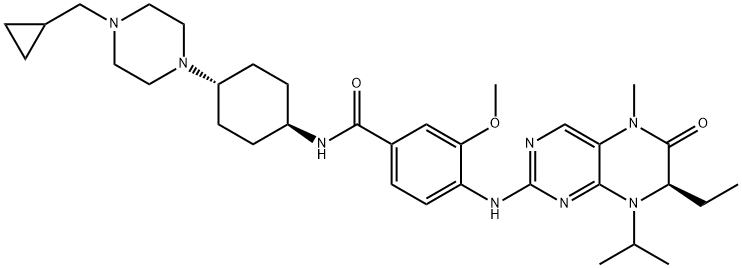Volasertib (BI 6727) is a highly potent Plk1 inhibitor with IC50 of 0.87 nM in a cell-free assay. It shows 6-and 65-fold greater selectivity against Plk2 and Plk3. Phase 3.
A high volume of distribution, indicating good tissue penetration, and a long terminal half-life.
Like BI2536, BI6727 is an ATP-competitive kinase inhibitor from the dihydropteridinone class of compounds. In addition to Plk1, BI6727 also potently inhibits two closely related kinases Plk2 and Plk3 with IC50 of 5 nM and 56 nM, respectively. BI6727 at concentrations up to 10 μM displays no inhibitory activity against a panel of >50 other kinases. BI6727 inhibits the proliferation of multiple cell lines derived from various cancer tissues, including HCT116, NCI-H460, BRO, GRANTA-519, HL-60, THP-1, and Raji cells with EC50 of 23 nM, 21 nM, 11 nM, 15 nM, 32 nM, 36 nM, and 37 nM, respectively. BI6727 treatment (100 nM) in NCI-H460 cells induces an accumulation of mitotic cells with monopolar spindles and positive staining for histone H3 phosphoserine 10, confirming that cells are arrested early in the M phase, followed by induction of apoptosis. Low nanomolar concentrations of BI6727 display potent inhibitory activity against neuroblastoma (NB) tumor-initiating cells (NB TIC) with EC50 of 21 nM, whereas only micromolar concentrations of BI6727 are cytotoxic for normal pediatric neural stem cells. BI6727 induces growth arrest of Daoy and ONS-76 medulloblastoma cells similar to BI 2536.
Administration of BI6727 significantly inhibits the growth of multiple human carcinoma xenografts including HCT116, NCI-H460, and taxane-resistant CXB1 colon carcinoma, accompanied by an increase in the mitotic index as well as an increase in apoptosis. In in vivo studies, BI6727 shows better toxicity and pharmacokinetic profile compared to BI2536.
Volasertib (755038-65-4) is an extremely potent and selective inhibitor (IC50’s: Plk1= 0.87 nM, Plk2 = 5 nM, Plk3 = 56 nM) of Polo-like kinase 1, a critical controller of multiple essential steps of mitosis.1?It has shown efficacy in multiple solid xenograft tumors models1?and in clinical studies in patients with acute myeloid leukemia2. Volasertib has also been shown to potently inhibit BRD43?(Kd = 79 nM3, IC50’s bromodomains 1 and 2 of BRD4 = 300 and 770 nM respectively2).
Volasertib (BI 6727) is a highly potent Polo-like kinase (PLK) inhibitor.
1) Rudolph?et al.?(2009)?BI 6727, a Polo-like kinase inhibitor with improved pharmacokinetic profile and broad antitumor activity; Clin. Cancer Res.?15?3094
2) Rudolph?et al.?(2015)?Efficacy and Mechanism of Action of Volasertib, a Potent and Selective Inhibitor of Polo-Like Kinases, in Preclinical Models of Acute Myeloid Leukemia; J. Pharmacol. Exp. Ther.?352?579
3) Ciceri?et al.?(2014)?Dual kinase-bromodomain inhibitors for rationally designed polypharmacology; Nat. Chem. Biol.?10?305


